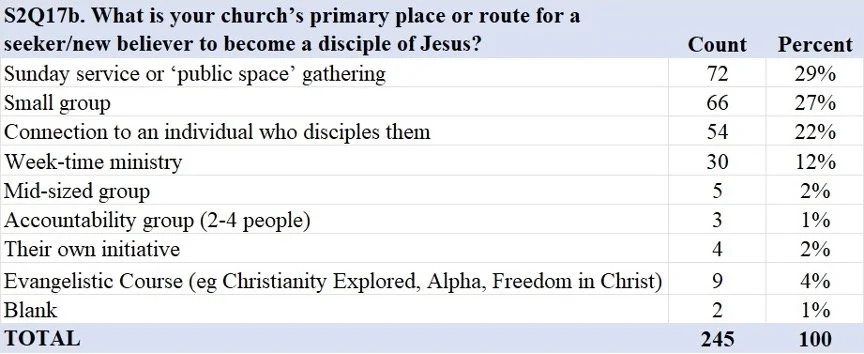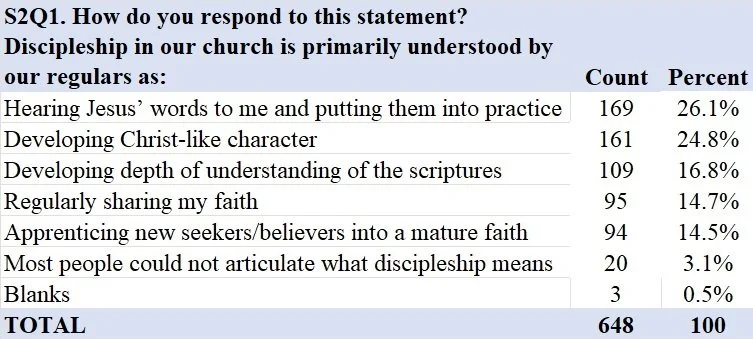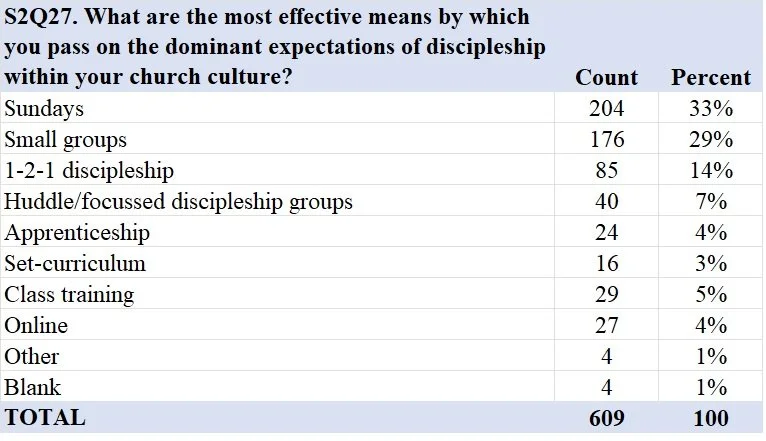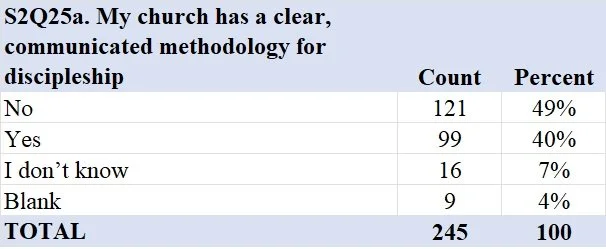
Missional Movement Through the Local Church: Applying Movemental Principles in a British Context
by Rev Dr Nick Allan
Research Findings
What the survey responses tell us about Addison’s six categories of missional movement
The survey was designed (without participants realising this) around a typology of six key themes identified by Steve Addison, the missiologist and specialist researcher into contemporary DMMs (Disciple-Making Movements).
1. Commitment to the cause
2. Relational connections
3. White-hot faith
4. Rapid Mobilization
5. Adaptive methods
6. Apostolic leadership culture
#1 Commitment to the cause
Addison’s first category of common factors in rapidly multiplying and CPMs (Church Planting Movements) CPMs and DMMs (Disciple-Making Movements) in the Global South relates to an obvious and sustained commitment to the cause of the movement.
Helpful practices:
Church Planting and the Multiplication of Groups
63% of churches (from a full spread of church attendance sizes, 94% Evangelical/Pentecostal) claimed multiplication was their primary vision and intention in some form, within which 26% stated an intention to plant new churches beyond their current organization. Most leaders who responded had some prior experience in church growth, which may have inflated these figures. Leaders reported a relatively strong intention, but lower levels of confidence in the reality that church planting could occur through conversion growth.
The interviews with movemental practitioners had a strong emphasis upon the significance of developing and communicating a clear vision for kingdom-of-God multiplication. Leaders held a variety of approaches towards multiplication. Some spoke of ‘church planting’ (Resource Church leaders, for example), while those typically influenced by micro-church and DMM methodology spoke of ‘gospel planting’ as the aim, which they expected to lead to the formation of new ecclesial communities in due course. “We plant the gospel, we grow disciples, and then we raise churches from those discipleship communities”. Those leaders with a clear vision for planting or multiplication emphasized the significance of using a common language to communicate this vision unequivocally to their congregants.
Training
Churches reported a high amount of training overall, but the evidence suggests that training practices which explicitly promote missional discipleship were limited. Some leaders, particularly DMM practitioners, consistently train their people in how to share their faith and lead others into faith, with the expectation that they will quickly do the same to others.
Churches offered training opportunities in:
· “evangelism” “almost continuously/regular basis” (31%) “occasionally” (58%).
· “leading somebody to faith” (20%) & (55%)
· “discipling a new believer” (55%) & (24%)
40% of leaders stated that their church had a clear, communicated methodology for discipleship. 61% agreed/strongly agreed that “my church’s discipleship methodology (of whatever kind) is simple and replicable”.
The Practice of Evangelism (Corporate & Individual)
The corporate practice of evangelism evoked a significant response, as might be expected from a majority evangelical sample. Over one-third built this as a regular or continuous practice in their church, a further 53.9% arranged such events “occasionally”.
Several best-practice leaders commented explicitly that they operated an “attractional” model of invitational, come-to-us evangelistic events while several others highlighted the significance of their city or town-centre buildings for missional and evangelistic opportunities, both as highly attractional bases and in opportunities to serve the urban poor/vulnerable. Micro-church and DMM practitioners also commented on the significance of place in providing corporate evangelistic opportunities occurring in innovative locations away from traditional church settings, such as leisure events (one micro-church began a local basketball night in a gym to grow relational connections with non-Christians) and entrepreneurial ventures like a pop-up coffee shop.
Beyond the practice of evangelism some survey questions asked about the results of such practices.
17% of churches estimated between 5–10% and a further 9% of churches estimated above 10% of their congregants leading somebody to faith in the previous year
Regarding the evangelistic practice of new believers, their engagement was demonstrably stronger. 63% agreed/strongly agreed that “new believers within our church very soon begin to share their faith with others, and seek to make disciples of others”
Hindering practices:
Lack of Intentionality in Church Planting and the Multiplication
Three quarters of churches had no intention of church planting or multiplying beyond their existing set-up. 74% stated that their church’s vision and intention was not seeking to multiply beyond their existing one church.
37% aimed to maintain and develop a healthy single congregation of believers (churches typically smaller in size and not charismatic in their spirituality)
Only 26% held a vision and intention of planting new churches
Church leaders shared opinions about conditions and attitudes within the UK church which tend to hinder multiplication and church planting. Several spoke about the impact of the UK’s inherited models of church inhibiting the imagination “things have always been this way” and appetite of congregants towards new forms of church, particularly in those generations above Gen-X. A few aired frustration that their own denominations and their relationship to their regional governance structures such as their diocese were a hindering factor. Several described the pressure on clergy/leadership in smaller churches of feeling already overstretched, of carrying the burden of responsibilities to ‘keep the show on the road,’ and in two cases of near ‘burn out’, all of which detracted from theirs and the church’s missional focus and momentum.
Insufficient Commitment to a Missional Mindset
Survey & interviews revealed three key factors:
congregant’s perceptions of church;
a cultural stronghold of consumerism and individualism within congregants;
a lack of confidence of congregants.
Evangelism and the creation of new groups or micro-churches based around new converts is a key feature in CPMs and DMMs. Both research instruments revealed attitudes and practices within UK leaders and churches which diverge from such a committed picture.
When asked the question “people in my church feel confident and equipped to share their faith (evangelism) with non-believers” only half (52%) of respondents agreed/strongly agreed, and one-third (32%) disagreed/strongly disagreed, with a further 16% responding “I don’t know” (S2Q11). This equates to almost half of respondents identifying a significant gap in their congregants’ confidence and capability in this area.
Church practices contributed:
• 11% never offer training opportunities in “Evangelism”
• 22% never offer training opportunities in “leading somebody to faith”
• 20% never offer training opportunities in “discipling a new believer/seeker”
• 62% estimated that between 1–5% of their people had led somebody to faith within the past year.
• 11% estimated that none of their people had led anybody to faith
#2 Relational Connections
Helpful practices:
Corporate Initiatives to Build Relational Connections with Non-Christians
Leaders reported how they frequently created opportunities “for people to encounter Jesus Christ in a meaningful way” outside of their weekend worship gatherings (monthly/more frequently 75%), and (weekly/more frequently 48%). They mixed a variety of type/size of groups and spaces. Frequently this happened through events that mixed practical community service with the opportunities for relationship building and evangelism with non-Christians. These included church-run cafés, foodbanks, debt advice centres, and partnerships with other local service providers like an arts centre or sports club.
Regular corporate evangelistic events were frequently arranged by church communities
· 58% viewed Sundays as the primary entry-point for a seeker/new believer into the life and body of their church.
· 16% through a personal relational connection
Hindering practices:
The survey returned evidence of a lack of significant momentum in people being converted through Christians who attend church. Conversions are occurring, but on a one-by-one basis and not in any kind of exponential fashion as is more typical in the rapidly growing CPMs. UK churches in this survey relied upon corporate events to harvest conversions, rather than conversions tending to occur through the relational connections of confident individuals evangelizing in their own contexts of life. An exception to this model was the micro-churches and DMM practitioners, who focus almost exclusively upon building relational connections between Christians and non-Christians as their primary mode of evangelism. However, the research identified that these sincere Christians were not actually seeing very many conversions occur.
Low Levels of Evangelism
only 5% of responses (representing 11 churches) was the estimate that twenty-percent or more congregants had led somebody to faith within the past year
11% none of congregation had led somebody to faith within the past year
congregants’ lack of social networks and relational connections with non-Christians was a significant hindrance to creating a culture of missional movement. “We just don’t disciple people quickly into what it means to do mission with the people. So people join our church, they make friends with all the people in the church. They kind of lose their friends who’ve not Christians, and so they’ve lost all the missional potential of those relationships.”
The evidence suggests a strong correlation between churches not arranging regular corporate evangelistic events, and churches not seeing any significant number of people come to faith. 9.4% of responding churches reported never arranging these.
Over-Reliance on Corporate Outreach
There appears to be an over-emphasis upon gathered corporate methods of evangelism, in comparison to the best-practice of CPMs and DMMs in the Global South.
When leaders were asked to identify “the primary entry-point for a seeker/new believer into the life and body of your church” only 16% of cases was the primary entry-point for a seeker/new believer into the life and body of your church is through “connection to an individual who disciples them.”
Only 22% said their primary route to discipling a new believer was through “connection to an individual who disciples them”; and 1% through an “accountability group (2–4 people).
#3 White Hot Faith
Addison’s third category relates to the level of faith and expectation at the centre of the organization.
Helpful practices:
Interviews with leaders demonstrated that those churches exemplifying best practice were willing to structure and often re-shape their church’s activities to meet their missional vision and purpose.
Prayer Culture
A church’s prayer culture is arguably one of the strongest indicators of the category of white-hot faith. Both research survey and interviews returned a very high positive response rate regarding the place and role of prayer within the mission of the local church. The vast majority of churches reported an outward focus to their prayers, and from a faith perspective they would seem to place high value on the role of intercession as making a difference.
· 80% agreed/strongly agreed that “my church’s mission is fuelled by regular rhythms of corporate prayer”
Every best-practice interview identified prayer as central to their church culture and a major cause of their missional momentum. There were so many positive mentioned that it bears repeating many of their phrases:
· “prayer is the strategy”
· “we are fuelled by prayer”
· “prayer is the engine room”
· “one of our values is ‘powered by prayer’”
· “This one statement probably says it all, that mission is powered by prayer, not activities. So if mission is powered by prayer, then it means that we are helpless without prayer”
Church leaders were invited to share their personal practices regarding fasting. Church leaders engage in fasting personally on a much more regular basis than what they call their churches to engage in corporately. 30% engage in fasting once or twice a year, 40% engage more than twice a year, and 33% of respondents engage monthly or more frequently than monthly. Overall, 70% of leaders engage in personal fasting, while 29% of respondents never engage in personal fasting.
Training
Churches provided regular teaching or training in a variety of topics which contribute to white-hot faith (see table below):
Hindering practices:
Prayer, Faith and Supernatural Culture (and Prophetic)
It is not simple to measure the levels of faith or attitudes to life in the power of the Holy Spirit within churches, but the prevalence of certain practices gives some indication of how high they may be valued. A key factor in why CPMs and DMMs flourish is their internal ‘engine’ of faith, of passionate prayer and missional life in the power of the Holy Spirit. This was evidently a driver to mission in the New Testament early church. In the survey over one-third of churches surveyed were not actively seeking or expecting to experience miracles and the supernatural move of God, 35% disagreed/strongly disagreed or did not know. Addison’s observations of movements with ‘white hot faith’ are that they create mechanisms to generate habits and behaviours within people to sustain high levels of commitment and expectation. However, results suggest that there was a weak culture of intentionality towards discipling people within churches and a low emphasis upon actively seeking or expecting to experience miracles and the supernatural move of God.
When asked “which of the following would describe your church’s corporate prayer culture?” the response which received the most significance, by far outstripping other responses, was that a church’s prayer culture “sustained by a few people”. This would seem to suggest that it is not yet a movemental prayer culture. It is not decentralized, replicating and reproducing in the lives of many.
Discipleship Training
Over half of churches surveyed (56%) said they did not have or did not know whether they had “a clear, communicated methodology for discipleship”. One-third of churches (33%) disagreed that “my church’s discipleship methodology (of whatever kind) is simple and replicable”.
Leaders commented that it takes a lot of time to disciple new believers, especially if they come from backgrounds of trauma, controlling behaviours or complex social issues. Others identified a lack of leadership training within the local church, and the challenge of integrating new joiners and new converts into their church and transferring their missional ‘DNA’ to them.
47% of churches did not have a fixed-term program of equipping congregants in discipleship, such as internships or ministry schools.
The majority of these were churches with fewer than 200 congregants, and many were average sized under 50.
#4 Rapid Mobilization
Addison’s fourth category relates to rapid mobilization of congregants in obedience to Godly guidance and principles, and into leadership roles.
Helpful practices:
Obedience-based Discipleship
The survey returned some evidence that churches understood the value of obedience-based discipleship, which is a key factor in DMM/CPMs. The most common response at 26.1% to the statement “discipleship in our church is primarily understood by our regulars as:” was “Hearing Jesus’ words to me and putting them into practice” (see table below). This is not a high figure, but the best-practice leaders interviewed demonstrated that they have systems in place to train people in intentionally hearing from God and putting it into practice, including regular ‘huddles’ or mentoring of lay leaders by senior leaders as well as resources and training in a variety of discipleship pathways for all congregants. Some churches exhibited good practices by intentionality training in faith sharing, and Discovery Bible Study methodologies which support obedience-based discipleship. Micro-church and DMM practitioners modelled and taught this immediately to new disciples, indeed they spoke of how their definition of discipleship would be incomplete without such rapid mobilization of new joiners.
Removing Barriers to Discipleship and Leadership
Most church cultures now foster leadership development and the exercise of people’s gifts without requiring ordination. Over 90% of leaders agreed / agreed strongly that “the majority of ministries in my church are led by people who are by not ordained”.
Other survey responses seem to suggest that there was a bias towards raising leaders for the purpose of church-related and church-initiated service/ministries, rather than whole-of-life discipleship in the workplace or elsewhere.
· 73% agreed that “my church fosters a culture of creativity or empowerment which means that people frequently suggest or start new initiatives or ministries”
· In best-practice interviews leaders laid a strong emphasis upon the raising, training and empowerment of lay leaders and of the role of creativity within their missional culture, and of helping congregants to engage creatively, sometimes entrepreneurially or artistically, with their contexts for the sake of mission. Typically, the church leaders’ approach was to add their weight behind an idea by permission-giving, whilst empowering the congregant to turn it into reality themselves. One spoke of “investing in the few for the sake of the many”
Distributed Power
One survey question asked respondents to indicate on a ten-point Likert scale where power and authority lay within their church culture, between highly centralized power directed towards clergy/staff/leadership, and highly decentralized or “distributed” power/knowledge/influence towards the laity (Ford et al. 30). It served as an indicator of the empowerment and engagement of congregants beyond the staff/clergy. It indicated how much regular congregants expected, as part of their church’s culture and practices, to take responsibility and hold authority for kingdom and missional actions including evangelism, creating relational connections and taking responsibility for leadership and mobilization beyond, as well as within, church-initiated ministries.
Although not overwhelming, the results offer some indication of movemental principles in operation. Over one-third of respondents report power to lie predominantly in a decentralized, distributed manner. There was a distinct difference in the attitude of those from micro-churches. Leaders of churches operating with ordained clergy or staff teams and an inherited, gathered model of church frequently referred to the significance of strong centralized leadership in creating and maintaining a movemental culture. They gave examples such as the setting and communication of vision and values and the modelling of a missional lifestyle as being centre-led. However, they also laid great significance on utilizing and engaging their congregations in a discipleship lifestyle, giving examples such as releasing volunteers to support emerging projects or creating ‘discipleship pathway’ resources. One leader’s comment was typical, who described constantly raising lay teams so that initiatives no longer needed to be clergy/centre-led. Those leaders of micro-churches and DMM practitioners diverged in their approach, describing highly decentralized cultures and a flat leadership structure shared by most of their, albeit small, congregation.
Hindering practices:
Rapid mobilization relates to the lowering of barriers to leadership, to empowering everyday believers, and to people learning missional discipleship through on-the-job / apprenticeship models rather than through knowledge-first models. One leader described this as a focus upon application not just information (I3). This would seem to require regular training in topics which enable widespread missional engagement, and this cannot be confined to clergy or to specialists.
As noted in #1 above, significant percentages of churches surveyed never offer training opportunities in “Evangelism” (11%), “leading somebody to faith” (22%), or “discipling a new believer/seeker” (20%). This absence of direct training in these fields in local churches will clearly hinder movemental momentum.
Leaders were asked to rank how discipleship was primarily understood by their “regulars”. The second and third most common responses were “developing Christ-like character” (24.8%) and “developing depth of understanding of the scriptures” (16.8%). While these are laudable aims, it is arguable that they could work against rapid mobilization. If taught from the pulpit or emphasized within small groups (which 86.5% of survey respondents utilize), this is likely to have an emphasis upon ‘going deep’ rather than ‘going out’ and upon the Christian life as being a personal, inward pursuit, rather than how disciples can develop their character by rapid obedience to the commands of Christ, such as ‘make disciples’.
When defining how discipleship was understood, the indicator of rapid outward-focused action “regularly sharing my faith” was selected in only 14.7% of cases, and “apprenticing new seekers/believers into a mature faith” in only 14.5% of cases
DMM practitioners who were interviewed identified a hindrance that their congregants placed too much emphasis upon gaining knowledge and not enough upon obedience.
“We use the Discovery Bible Study tool as well to try and help us be a bit more application focused rather than just knowledge focused. One of the things I would say as a hindrance with Christians is that they crave knowledge, but they don’t really know how to put it into practice”
This research suggests that there is a lack of direct training and modelling of obedience-based, often costly, and collectivist discipleship within the still-prevalent Christendom paradigm and inherited forms of church. A significant number of church leaders commented that most Christians have neither seen nor experienced being discipled themselves in this manner. Since this had never been modelled to them, when faced with the concept of ‘whole-life discipleship’ leaders reported that it came as both a surprise and a challenge to Christians
Distributed Power
While tentatively mentioned above as a ‘positive’, the majority of surveyed churches weighted their practices towards centralized events and clergy-held power.
a significant percentage of churches (almost one-quarter) operated a strong Sunday-only focus “for people to encounter Jesus Christ in a meaningful way”
On a Likert scale measuring where power and authority lay within their church culture, 38% of churches were grouped on the scale where power and authority lies in the majority towards the clergy
One interviewee commented that churches can become too focused and reliant upon their staff team, so that the discipleship of individuals within the church declines since the over-reliance upon a small number of staff acts as a bottleneck
Lack of Confidence in Evangelism
When asked “people in my church feel confident and equipped to share their faith (evangelism) with non-believers”
32% identified a significant gap in their congregants’ confidence and capability in this area by disagreeing /strongly disagreeing. 16% responded “I don’t know” (S2Q11). Thus, almost half of all respondents in total were not able to say their people were confident and equipped. This will clearly hinder rapid mobilization.
One interviewee described a “clergy get-out clause” whereby they discipled only existing Christians as being unbiblical and unacceptable in creating a culture of missional movement within the local church.
#5 Adaptive Methods
Helpful practices:
Keep Methodologies in Review Against Desired Outcomes
The majority of respondents in both research instruments indicated a significant willingness to adapt their methods to meet their mission.
· 60% agreed/strongly agreed with the statement “my church has a variety of expressions of church to match the social/geographical context we are seeking to reach in mission”
· 63% agreed/strongly agreed that they “would describe our practices as ‘mission-fixated’ in the sense that mission underpins everything that we do as a church”
· Most best-practice churches commonly described innovative attempts to engage missionally with their contexts. This was a dominant feature of micro-churches and DMM practitioners, but most large inherited-model churches also gave significant emphasis to developing outreach beyond their Sunday programs, usually through lay leadership.
· All best-practice leaders demonstrated various means in which they listened to their missional context and were responsive to it in designing missional methods. The post-COVID19 cultural landscape was a key driver for some churches, others encouraged their congregants to join in with existing initiatives like CAP debt advice, foodbanks, and refugee aid. They reported huge opportunities for evangelism arising through these social action projects.
Teaching, Training and Equipping Congregants towards Adaptive Methods
Some churches demonstrated good practice by a commitment to equipping their congregants in skills or mindsets which were likely to produce missional innovation and adaptive methods, not only through church-initiated activities, but in their personal lives.
· 53% ran or utilized a fixed-term program of equipping such as internships or ministry schools, which is an indication of intentionality to train Christians in missionary mindsets.
· 47% of church leaders responded that their church developed leaders by an apprenticeship model (including curacies, internships, discipleship-years)
· 44%, agreed/strongly agreed that “my church raises leaders rapidly into the discipleship of others, both within and beyond formal church structures/ministries”
Best-practice leaders most frequently demonstrated a commitment to raising leaders through an apprenticeship model, one that focused upon one-to-one discipleship and in learning ministry and missionary skills in close contact to more experienced individuals. Their models for doing so included one-to-one mentoring and small ‘huddles’ of a few key individuals being mentored by a church leader.
Hindering practices:
Failure to Utilize a Variety of Group Sizes
Several survey questions related to group sizes, structures and purposes which indicate how churches were potentially missing opportunities to utilize adaptive methods.
· Just over 57% of churches surveyed did not utilize ‘personal space’ sized groups of between two to four people. DMM scholars have shown this size to be a powerful group size for fostering obedience-based discipleship and the apprenticeship model of discipleship of seekers / new believers because of to their high levels of interaction, trust and accountability (Watson and Watson 148).
· 65% did not utilize ‘social space’ sized groups of 15–40 people, which missiologists identify as a potentially flexible, adaptable social dynamic in which to innovate, raise leaders, build relational connections, gather missional momentum (McNeal; Breen and Absalom).
The genuine expectation that a new believer will become a disciple of Jesus primarily through attending a public space gathering is flawed. It is not movemental because of the high maintenance, high skill levels that are required by large numbers of people to put on a Sunday service or public-space gathering on a regular basis. It is not an adaptive method for the 21st century; although as a harvesting tool, it still has its place.
When churches were asked “what is your church’s primary place or route for a seeker/new believer to become a disciple of Jesus?” the most common selection at 29% was “Sunday service or ‘public space’ gathering”.
When asked “what are the most effective means by which you pass on the dominant expectations of discipleship within your church culture?” Sundays (33% of all selections) and small groups (29%) were the two most common means.
These methods are not adaptive or new and are unlikely to train and equip people in the application or understanding of adaptive methods. The next three most common responses, “1-2-1 discipleship”, “huddle” and “apprenticeship” hold the potential for fostering adaptive methods in people, but they received very low response rates.
Deficiencies in Teaching, Training and Equipping Congregants towards Adaptive Methods
The most common teaching within the churches represented was aimed at personal spiritual growth, specifically the spiritual disciplines, the role of the Holy Spirit, and effective prayer habits. There was limited teaching in topics that could contribute to adaptive methods, and it was in the minority.
· the most common topic “evangelism and faith sharing” was only taught/trained regularly in 11.7% of churches
· “discipleship of new believers / seekers” (10.2%); “personal calling / vocation” (8.6%); “identifying and growing in Ephesians 4 ‘five-fold’ gifting (sometimes called APEST)” (6.5%); “Godly-decision making” (5.5%)
DMM theory says that one of most significant reasons for the movemental transmission of the gospel is a simple, repeatable and transferable structure or pattern for discipleship. UK church leaders claimed in the RI1 survey that they are raising disciples and training in discipleship, and that the most effective means by which they pass on the dominant expectations of discipleship is Sundays (33% of all selections) and small groups of approximately four to fifteen people (29%). They further claimed that discipleship was high on their agenda since 55% of churches offer almost continuous or regular training in discipling a new believer/seeker. Yet, it is legitimate to question just how effective a local church’s discipleship is since a cumulative 56% of churches did not have, or did now know whether they had, a clear discipleship methodology (see table below).
#6 Apostolic Leadership Culture
Addison’s sixth category relates to what he calls “pioneering or apostolic leadership”
Helpful practices:
Vision
Regarding a church’s self-understanding and vision, a number of survey questions produced responses which had the potential to indicate apostolic intent.
63% agreed/strongly agreed that they “would describe our practices as ‘mission-fixated’ in the sense that mission underpins everything that we do as a church”
57% “my church’s vision and intention are to plant new churches (or groups) primarily through conversion growth”
75% will communicate to some extent regarding their church “the expectation that it will reproduce itself (i.e. planting a new expression of the church in another populace or people group)”
35% agreed/strongly agreed that “my church has a clear pathway for training and deploying potential church planters” [which means 65% did not…)
40% stated that their church had a clear, communicated methodology for discipleship
61% that “my church’s discipleship methodology (of whatever kind) is simple and replicable”
Hindering practices:
The evidence indicates that, beyond the good-practice examples selected for interview, the majority of churches did not operate in a culture of pioneering or apostolic leadership. In addition to the low levels of intentional training in church planting and personal faith sharing previously discussed, a high proportion of churches indicated that they were not intending to multiply and grow their churches beyond the existing congregation.
32% had no “vision and intention are to plant new churches (or groups) primarily through conversion growth”
62% disagreed that “my church has a clear pathway for training and deploying potential church planters”, and only 35% agreed
35% of churches disagreed of did not know if their church practices could be described “as ‘mission-fixated’ in the sense that mission underpins everything that we do as a church”










